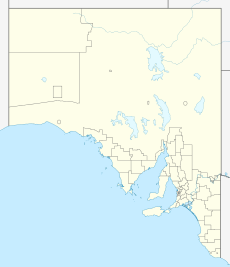The Pages Conservation Park facts for kids
Quick facts for kids The Pages Conservation ParkSouth Australia |
|
|---|---|
|
IUCN Category Ia (Strict Nature Reserve)
|
|
| Nearest town or city | Cape Jervis |
| Established | 16 March 1967 |
| Area | 70.23 km2 (27.1 sq mi) |
| Visitation | 'few visitors' (in 1983) |
| Managing authorities | Department for Environment and Water |
| See also | Protected areas of South Australia |
The Pages Conservation Park is a special protected area in South Australia. It includes a group of islands called The Pages and the waters around them. These islands are located in a place called Backstairs Passage. They are about 25 kilometers (15.5 miles) south-east of Cape Jervis and about 98 kilometers (61 miles) south-south-west of Adelaide, the capital city.
This park helps protect the unique animals and plants that live there. It's a very important place for nature.
Contents
What is The Pages Conservation Park?
The Pages Conservation Park is a type of protected area in Australia. This means the land and water are kept safe from harm. The park covers about 70 square kilometers (27 square miles). It includes two small islands and a reef.
Why Was the Park Created?
The islands first became a protected area on March 16, 1967. They were called a "fauna conservation reserve." This was to protect the animals living there. Later, on April 27, 1972, it officially became The Pages Conservation Park.
In 1997, the park's boundaries were made bigger. They were extended 2 nautical miles (3.7 kilometers) out into the sea. This was done to help control activities like "berleying" and "shark cage diving." Berleying is when people throw bait into the water to attract sharks. This expansion helps keep the sharks and their environment safe.
Amazing Animals and Plants
The Pages Conservation Park is a very important home for wildlife. It's known for its large breeding colony of Australian sea lions. These amazing animals use the islands to have their pups and rest. Many seabirds also live and breed here.
The islands are mostly rocky. But on their flatter tops, you can find small shrubs like Senecio lautus. In small patches of soil, there are also plants like Atriplex and Bulbinopsis bulbosa. On the steeper slopes, you might see plants like Disphyma clavellatum and Enchylaena tomentosa.
Because the islands are isolated and not many people visit, the natural environment has stayed very healthy. There are no introduced animal species that could harm the native wildlife. This helps keep the habitat safe and sound for all the creatures that call it home.
How is the Park Protected?
The Pages Conservation Park is classified as an IUCN Category IA protected area. This is the strictest type of protected area. It means the park is mainly for scientific research and protecting wilderness. Human visits are very limited to make sure the environment is not disturbed.
In 1980, the park was also listed on the Register of the National Estate. This was a list of places in Australia that were important for their natural or cultural value.


